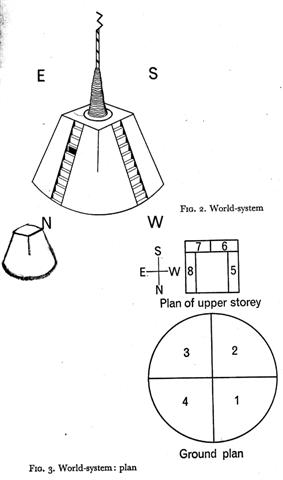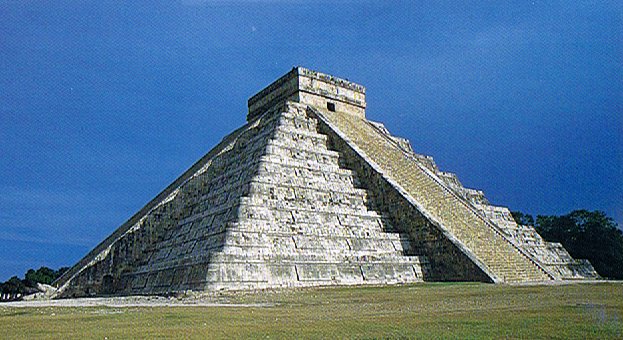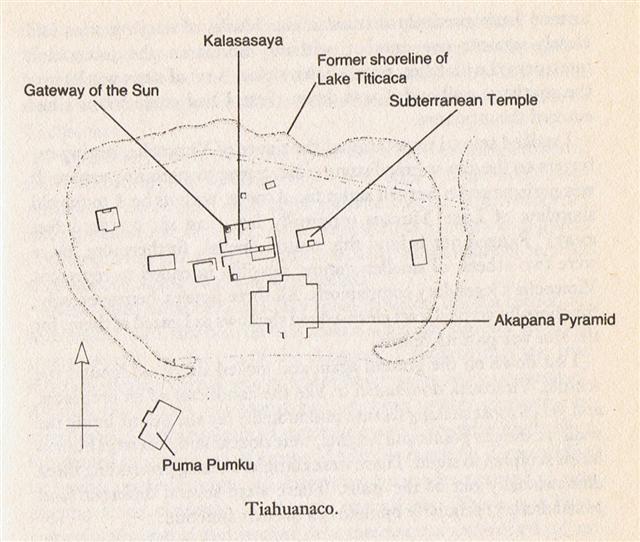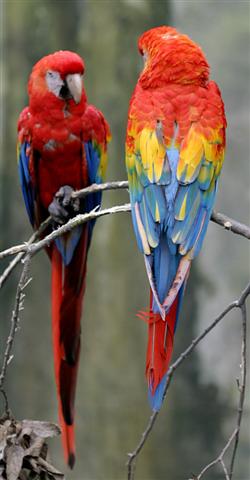Cosmos is synchronous - everything dances in coordination. The rhythms are the same but not the dancers nor the words of their songs. ... The white egret took its piece [of the skin of 'Keyemen - the rainbow in the shape of a huge watersnake'] and sang, 'ā-ā', a call that it still has to this day. The maguari (Circonia maguari, a stork) did likewise and uttered its ugly cry: 'a(o)-a(o)'. The soco (Ardea brasiliensis, a heron) placed its piece on its head and wings (where the colored feathers are) and sang, 'koro-koro-koro'. The kingfisher (Alcedo species) put its piece on its head and breast, where the feathers turned red, and sang, 'se-txe-txe-txe'. Then it was the toucan's turn. It covered its breast and belly (where the feathers are white and red). And it said: 'kión-he, he kión-he'. A small piece of skin remained stuck to its beak which became yellow. Then came the mutum (Crax species); it put is piece on its throat and sang, 'hm-hm-hm-hm' and a tiny remaining strip of skin turned its nostrils yellow. Next came the cujubin (Pipile species, a piping guan), whose piece turned its head, breast, and wings white: it sang, 'krr' as it has done every morning since. Each bird 'thought its own flute made a pretty sound and kept it.' The richly colored plumage of the macaw is explained by the fact that it seized a large piece of skin and covered its whole body in it ... The source from where it all began was the skin of the Rainbow, which according to the Babylonians was located between the Stag and Anunitum:
... Though Andromeda has its roots most firmly in the Greek tradition, a female figure in Andromeda's place appeared in Babylonian astronomy. The stars that make up Pisces and the middle portion of modern Andromeda formed a constellation representing a fertility goddess, sometimes named as Anunitum or the Lady of the Heavens ... The waterfilled rectangular mud garden Field close by served as a rice-paddy generating food at the top of the world. ... All was now ready for departure except that there was no fire in the smithy. The ancestor slipped into the workshop of the great Nummo, who are Heaven's smiths, and stole a piece of the sun in the form of live embers and white-hot iron. He seized it by means of a 'robber's stick' the crook of which ended in a slit, open like a mouth.
He dropped some of the embers, came back to pick them up, and fled towards the granary;
but his agitation was such that he could no longer find the entrances. He made the round of it several times before he found the steps and climbed onto the flat roof, where he hid the stolen goods in one of the skins of the bellows, exclaiming: 'Gouyo!', which is to say. 'Stolen!'. The word is still part of the language, and means 'granary'. It is a reminder that without the fire of the smithy and the iron of hoes there would be no crops to store ... During his descent the ancestor still possessed the quality of a water spirit, and his body, though preserving its human appearance, owing to its being that of a regenerated man, was equipped with four flexible limbs like serpents after the pattern of the arms of the Great Nummo. The ground was rapidly approaching. The ancestor was still standing, his arms in front of him and the hammer and anvil hanging across his limbs. The shock of his final impact on the earth when he came to the end of the rainbow, scattered in a cloud of dust the animals, vegetables and men disposed on the steps. When calm was restored, the smith was still on the roof, standing erect facing towards the north, his tools still in the same position. But in the shock of landing the hammer and the anvil had broken his arms and legs at the level of elbows and knees, which he did not have before. He thus acquired the joints proper to the new human form, which was to spread over the earth and to devote itself to toil ... The Dogon had a Stolen Granary with a flat square roof, but instead of birds taking pieces from the skin of the rainbow watersnake the Smith used the skin as a bag to hide a piece of the sun.
... Behind me, towering almost 100 feet into the air, was a perfect ziggurat, the Temple of Kukulkan. Its four stairways had 91 steps each. Taken together with the top platform, which counted as a further step, the total was 365. This gave the number of complete days in a solar year. In addition, the geometric design and orientation of the ancient structure had been calibrated with Swiss-watch precision to achieve an objective as dramatic as it was esoteric: on the spring and autumn equinoxes, regular as clockwork, triangular patterns of light and shadow combined to create the illusion of a giant serpent undulating on the northern staircase ...
... I walked towards it now, and spent some time strolling around it and clambering over it. Originally it had been a clean-sided step-pyramid of earth faced with large andesite blocks. In the centuries since the conquest, however, it had been used as a quarry by builders from as far away as La Paz, with the result that only about ten per cent of its superb facing blocks now remained. What clues, what evidence, had those nameless thieves carried off with them? As I climbed up the broken sides and around the deep grassy troughs in the top of the Akapana, I realized that the true function of the pyramid was probably never going to be understood. All that was certain was that it had not been merely decorative or ceremonial. On the contrary, it seemed almost as though it might have functioned as some kind of arcane 'device' or machine. Deep within its bowels, archaeologists had discovered a complex network of zigzagging stone channels, lined with fine ashlars. These had been meticulously angled and jointed (to a tolerance of one-fiftieth of an inch), and had served to sluice water down from a large reservoir at the top of the structure, through a series of descending levels, to a moat that encircled the entire site, washing against the pyramid's base on its southern side ... To raise a pyramid of stones is in thought quite similar to raising high the Milky Way River ('watersnake'):
... Men and birds joined forces to destroy the huge watersnake, which dragged all living creatures down to his lair. But the attackers took fright and cried off, one after the other, offering as their excuse that they could only fight on dry land. Finally, the duckler (K.G.: a diver) was brave enough to dive into the water; he inflicted a fatal wound on the monster which was at the bottom, coiled round the roots of an enormous tree. Uttering terrible cries, the men succeeded in bringing the snake out of the water, where they killed it and removed its skin. The duckler claimed the skin as the price of its victory. The Indian chiefs said ironically, 'By all means! Just take it away!' 'With pleasure', replied the duckler as it signalled to the other birds. Together they swooped down and, each one taking a piece of the skin in its beak, flew off with it. The Indians were annoyed and angry and, from then on, became the enemies of birds. The birds retired to a quiet spot in order to share the skin. They agreed that each one should keep the part that was in its own beak. The skin was made up of marvelous colors - red, yellow, green, black, and white - and had markings such as no one had ever seen before. As soon as each bird was provided with the part to which it was entitled, the miracle happened: until that time all birds had had dingy plumage, but now suddenly they became white, yellow, and blue ... The parrots were covered in green and red, and the macaws with red, purple, and gilded feathers, such as had never before been seen. The duckler, to which all the credit was due, was left with the head, which was black. But it said it was good enough for an old bird ...
... and then, with stunning abruptness, at a crucial date that can be almost precisely fixed at 3200 BC (in the period of the archaeological stratum known as Uruk B), there appears in this little Sumerian mud garden - as though the flowers of its tiny cities were suddenly bursting into bloom - the whole cultural syndrome that has since constituted the germinal unit of all the high civilization of the world ...
|







.jpg)

